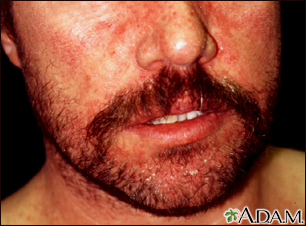Seborrheic dermatitis
Dandruff; Seborrheic eczema; Cradle cap
Seborrheic dermatitis is a common inflammatory skin condition. It causes flaky, white to yellowish scales to form on oily areas such as the scalp, face, or inside the ear. It can occur with or without reddened skin.
Cradle cap is the term used when seborrheic dermatitis affects the scalp of infants.

This is a close-up of seborrheic dermatitis. Note the redness (erythema) and mild scaling. Individuals with AIDS frequently develop seborrheic dermatitis or other types of skin rashes, as seen in this person.

This is seborrheic dermatitis on the face. Note the redness (erythema) and mild scaling. Individuals with AIDS frequently develop seborrheic dermatitis or other types of skin rashes, as seen in this person who is HIV positive.
Causes
The exact cause of seborrheic dermatitis is unknown. It may be due to a combination of factors:
- Oil gland activity
- Yeasts called Malassezia, which live on the skin, mainly in areas with more oil glands
- Changes in skin barrier function
- Your genes
Risk factors include:
- Stress or fatigue
- Weather extremes
- Oily skin, or skin problems such as acne
- Heavy alcohol use, or using lotions that contain alcohol
- Obesity
- Nervous system disorders, including Parkinson disease, traumatic brain injury, or stroke
- Having HIV/AIDS
Symptoms
Seborrheic dermatitis can occur on several body areas. It often forms where the skin is oily or greasy. Common areas include the scalp, eyebrows, eyelids, creases of the nose, lips, behind the ears, in the outer ear, and middle of the chest.
In general, symptoms of seborrheic dermatitis include:
- Skin lesions with scales
- Plaques over large area
- Greasy, oily areas of skin
- Skin scales -- white and flaking, or yellowish, oily, and sticky dandruff
- Itching -- may become more itchy if infected
- Mild redness
Exams and Tests
Diagnosis is based on the appearance and location of the skin lesions. Further tests, such as skin biopsy, are rarely needed.
Treatment
Flaking and dryness can be treated with over-the-counter dandruff or medicated shampoos. You can buy these at the drugstore without a prescription. Look for a product that says on the label it treats seborrheic dermatitis or dandruff. Such products contain ingredients such as salicylic acid, coal tar, zinc, resorcinol, ketoconazole, or selenium sulfide. Use the shampoo according to label instructions.
For severe cases, your health care provider will likely prescribe a shampoo, cream, ointment, or lotion containing either a stronger dose of the above medicines or containing any of the following medicines:
- Ketoconazole
- Ciclopirox
- Sodium sulfacetamide
- A corticosteroid
- Tacrolimus or pimecrolimus (medicines that suppress the immune system)
Phototherapy, a medical procedure in which your skin is carefully exposed to ultraviolet light, may be needed.
Sunlight may improve seborrheic dermatitis. In some people, the condition gets better in the summer, especially after outdoor activities.
Outlook (Prognosis)
Seborrheic dermatitis is a chronic (life-long) condition that comes and goes, but it can be controlled with treatment.
Severity of seborrheic dermatitis can be lessened by controlling risk factors and paying careful attention to skin care.
Possible Complications
The condition may result in:
- Psychological distress, low self-esteem, embarrassment
- Secondary bacterial or fungal infections
When to Contact a Medical Professional
Call for an appointment with your provider if your symptoms don't respond to self-care or over-the-counter treatments.
Also call if patches of seborrheic dermatitis drain fluid or pus, form crusts, or become very red or painful.
References
American Academy of Dermatology Association website. Seborrheic dermatitis: overview.
James WD, Elston DM, Treat JR, Rosenbach MA, Neuhaus IM. Seborrheic dermatitis, psoriasis, recalcitrant palmoplantar eruptions, pustular dermatitis, and erythroderma. In: James WD, Elston DM, Treat JR, Rosenbach MA, Neuhaus IM, eds. Andrews' Diseases of the Skin: Clinical Dermatology. 13th ed. Philadelphia, PA: Elsevier; 2020:chap 10.
Paller AS, Mancini AJ. Eczematous eruptions in childhood. In: Paller AS, Mancini AJ, eds. Paller and Mancini – Hurwitz Clinical Pediatric Dermatology. 6th ed. Philadelphia, PA: Elsevier; 2022:chap 3.
Version Info
Last reviewed on: 5/31/2023
Reviewed by: Ramin Fathi, MD, FAAD, Director, Phoenix Surgical Dermatology Group, Phoenix, AZ. Also reviewed by David C. Dugdale, MD, Medical Director, Brenda Conaway, Editorial Director, and the A.D.A.M. Editorial team.
